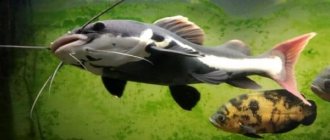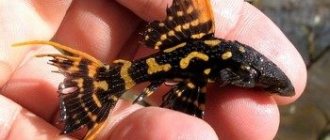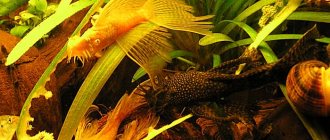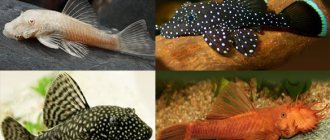Ancistrus are one of the most common aquarium catfish in the world. They owe their popularity to their unpretentiousness in maintenance, ability to get along with most types of fish and extravagant appearance. Light spots on a dark body combined with a bizarre suction cup mouth give this catfish a truly extraterrestrial appearance. This unusual appearance stimulates the emergence of a huge number of breeding forms, the most elegant of which is considered to be Ancistrus veilata.
Description
The veiled ancistrus is a true miracle of selection. Its main feature is its long fins that seem to flutter in the wind. Some aquarists associate them with graceful dragonfly wings, so the second name of the catfish sounds like “Ancistrus veil “dragonfly”.
Otherwise, the structure of this fish does not differ from the “source”. The body of the catfish is elongated, with a slightly flattened head. The entire surface of the body, with the exception of the abdomen and head, is covered with bone plates. The oral apparatus of the ancistrus consists of suckers and hard, keratinized scrapers, with the help of which the fish scrapes off algae and microorganisms from various surfaces. The dorsal fin of the dragonfly ancistrus is very beautiful: large, similar to a waving flag, it is most often pressed to the body. The pectoral and ventral fins are not much smaller than the dorsal fins in size and look just as decorative.
The structural features of ancistrus are explained by the fact that “wild” individuals live in reservoirs with strong currents. To prevent the fish from being carried away by the current, their mouthparts have acquired suction cups, which help the ancistrus to stay on stones and snags. For the same reason, they lack a swim bladder, as a result of which ancistrus prefer to remain at the bottom.
Features and habitat of synodontis
Synodontis is a collective name for many species of catfish, which have both similarities and distinctive features. One of the similarities is the homeland of almost all subspecies belonging to this name - the reservoirs of hot Africa.
The general conditions of maintenance and compatibility of Synodontis with other inhabitants of the aquarium are determined by the characteristics of a particular subspecies. Initially, there was not such a huge number of species and their mestizos, but currently the numerous points in the taxonomy of synodontis catfishes creates significant difficulties in determining whether a particular individual belongs to any species.
Despite this, most photos of synodontis smooth out their differences, so dim representatives of any point in the taxonomy of fish can be confused with another subspecies. As a rule, catfish have an elongated body, decorated with large fins and several pairs of movable whiskers on the muzzle. The male is usually smaller and more inconspicuous than the female Synodontis .
Maintenance and care
Veiled ancistrus are among the most unpretentious fish, which even a novice aquarist can handle keeping and breeding. However, this does not mean that ancistrus can live in absolutely any conditions. For them, as for any aquarium inhabitants, it is very important that the environment in which they live replicates the natural one as accurately as possible.
Minimum aquarium volume
The veiled ancistrus is a fish for which the volume of the aquarium is of paramount importance. The ease of caring for catfish often leads to the fact that people do not think about the size of the container, and keep ancistrus in twenty- or thirty-liter aquariums. This causes a lot of unpleasant consequences: the fish cannot grow normally, they dry out, and so-called stress spots appear on their body, which mean loss of pigment. They become more susceptible to a variety of diseases, including infectious diseases. In order to avoid such problems, you should make sure that there is at least eighty liters of water per two ancistrus.
Water composition
The properties that water must have for a comfortable life of ancistrus do not differ in special requirements:
• Acceptable water temperature is 20-28°C
• The acidity level ranges from 6 to 7.5
• Water hardness should not exceed 20°
Water changes should be carried out every week and amount to one third of the total volume.
Main varieties
Natural varieties of the Ancistrus chain catfish are as follows:
- Ordinary. In aquarium farming it is used for breeding ornamental species.
- Star (A. hoplogenys). At least twice as large as usual. The color is dark with white-blue spots resembling stars. It has light stripes along the edge of the fins and along the tail line. This heat-loving fish prefers water temperatures of +24...+28 °C, but easily adapts to other living conditions.
- Claro. A small catfish, maximum 7-8 cm. It is similar in color to the common ancistrus, differs in a different arrangement of spots on the body and fins. It was named after the river where it was first discovered.
- Ranunculus (A. ranunculus). It grows to a maximum height of 12 cm. It is most often found in reservoirs in the state of Pará, Brazil. The graphite body is covered with a scattering of small bluish specks.
- Black. In nature it reaches 20 cm; in aquariums its dimensions rarely reach 10 cm.
- Cryptofatalmus. It is difficult to reproduce in artificial reservoirs; the size does not exceed 7 cm.
- Starfish (Ancistrusleucostictus). Has a maximum size of 12 cm.
Breeders have developed artificial isomorphs based on natural species. Some of the most common varieties:
- Albino or white catfish - stuck.
- Red (A. Hoplogenys "Red") is a fairly mature Germanic species. It is distinguished by its brown color with light spots with an orange tint scattered throughout it. The fins have a red edge.
- Multispinnis (A. multispinnis). The body and fins are gray, yellowish or brown with dark spots.
- Tamboensis (A. tamboensis). The main background is light brown, the spots on the body and fins are orange.
- Bolivian (A. bolivianus). It is similar in color to tamboensis, but the spots are larger and form stripes reminiscent of tiger.
- Veiled. It differs from other species by its large veil-shaped fins. Sometimes they are equal in size to the length of the body.
- Diamond. Similar to the starfish, but the spots are lighter and larger.
- Golden (golden).
- Golden albino.
- Lutinous.
- Veiled albino.
Aquarium decoration
As you know, veiled ancistrus are bottom-dwelling fish, so the aquarium must have several types of shelters. These include all kinds of grottoes, caves, inverted vessels, coconut halves, as well as stumps and driftwood. In addition, it is very important to plant a sufficient amount of algae in the ground, which will not only imitate natural bodies of water, but will also help the catfish feel safe.
Lighting
Ancistrus are most active at night, therefore, bright light can cause serious stress. These catfish prefer soft and subdued lighting, but one cannot ignore the fact that light is necessary for the normal growth and development of algae, which form the basis of their diet. In order for the need for lighting of varying power to be satisfied, it is worth giving it a phase character, that is, allocating approximately equal amounts of time to the dark and light phases, between which there will be a forty-minute break for twilight.
Feeding
The diet of ancistrus dragonflies should be varied. These catfish are herbivorous and can obtain food themselves using mouth scrapers, with which they scrape off the smallest algae. Accordingly, most of the diet comes from plant foods, and only twenty percent from protein foods. Many aquarists prefer to feed them with tablet food, which catfish collect from the bottom. In addition, their diet should be supplemented with pre-scalded vegetables, which include cucumber, lettuce, spinach, pumpkin, cabbage and peas. From time to time, it is worth introducing live food into their menu, for example, tubifex and bloodworms. With proper, balanced nutrition and good care, ancistrus can live for seven years.
Nutrition
Like all other ancistrus, the veiled ancistrus prefers food of plant origin. Plant foods should make up 60-80 percent of the catfish's diet. Specialized foods that you can find in pet stores will help provide adequate nutrition for your clingy pets.
Please note that it is better to buy food from trusted sources and choose products from well-known manufacturers. SERA and Tetra have established themselves as industry leaders in the pet products market for quite some time now. They offer granulated food for catfish, the basis of which is a plant component.
Also, the diet of catfish should include protein foods. This can be food that is suitable for all other fish in the aquarium in the form of flakes or granules, as well as live food. It is worth paying attention to the fact that it is preferable to buy live food frozen. This will reduce the likelihood of infections and harmful microorganisms entering the aquarium along with food. Most of the bacteria that could be present with the food simply do not survive in such an environment.
Veiled ancistrus are especially fond of vegetables, which can be attached in slices to the bottom of the aquarium. It can be pumpkin, carrots, cabbage, and the most favorite delicacy of these catfish is cucumber.
Compatibility of veiled ancistrus
Ancistrus get along with most species of aquarium fish, but this does not mean that they cannot behave aggressively. Their mouthparts are a formidable weapon with which they can damage the skin of slow-moving and scaleless fish. Therefore, they should not be kept with aquarium inhabitants such as sacbranch catfish and goldfish.
Synodontis price and compatibility in the aquarium
You can buy synodontis for a very low price. In regular pet stores, catfish can cost from 50 rubles. Of course, the cost depends on the species, age, size, and distinctive features of a particular individual.
Synodontis, for the most part, are not aggressive towards other fish, especially if they are not bottom dwellers. When organizing the proximity of a catfish with other catfish or aggressive fish species, it is necessary to carefully observe their behavior in order to remove the culprit of a fight if one occurs. If the catfish lives with slow-moving fish, you need to make sure that there is enough food for everyone, since synodontis are extremely voracious and can eat their neighbors.
Reproduction and breeding
Breeding ancistrus dragonflies is a fairly easy process. If all the necessary conditions have been created for the fish, then they can begin to spawn on their own, in a common aquarium. If we are talking about targeted breeding, then in order for everything to go well, you need to follow simple instructions.
What you need for successful spawning
The key to successful breeding of veiled ancistrus is a spacious spawning area. Its minimum volume should be 40 liters. Only a couple of producers can be planted in such a container. For breeding a group consisting of a male and two females, a hundred-liter aquarium is suitable.
After the sex has been determined, the couple is placed in a spawning aquarium and they begin to stimulate reproduction by frequently changing the water, increasing its temperature within two degrees and increasing the proportion of live and protein food. The size ratio of the sires should not be neglected: females should be larger or the same size as the male. Otherwise, the male may injure or kill the small female.
Females prefer to spawn in special plastic pipes or long stumps, which must be equipped in advance in a hatchery. In addition, you need to install a filter and an aerator in it. After the female has laid her clutch, she is immediately removed, otherwise the male may seriously injure her. From now on, only the father takes care of the clutch. He constantly guards her, fanning her with his fins to stimulate an additional flow of oxygen and weed out dead eggs. He will remain at his post until the larvae hatch, after which the male should also be removed.
How do they reproduce?
To prevent the eggs from being eaten by other fish, it is best to use a separate aquarium for breeding. Ancistrus ripen in about a year; you can pick a pair yourself and plant them. For a maternity tank, choose an aquarium of approximately 50-60 liters. Fill it 2/3 with water from a common container and 1/3 with clean water. Set the temperature 2 degrees lower than in the main aquarium.
The only difference in the design of the spawning tank is that it must have a special shelter for spawning. You can make it yourself by fashioning a tube out of clay, or buy a ready-made piece of pipe or a piece of driftwood that is hollow inside. Such shelter is necessary, otherwise the female will leave eggs in the most unexpected place. There were cases when she threw it into the filter.
The male chooses the place for the offspring; he can do this for several days. The future nest will definitely be thoroughly cleaned, after which the process of courtship and spawning will begin. Most often, the female lays eggs at night; in the morning they should be immediately deposited back. Parental functions are performed by the male; he can even drive the mother away from the nest at this time.
On the 5th day the larvae hatch, but for another week they will gain strength in the nest. When they begin to move independently, the male loses interest in them; he has fulfilled his paternal functions. At this time, it can be returned to the general aquarium, and the fry can be fed with special tablets for catfish three times a day. Catfish can be transferred to a community aquarium at 6 months.
How to distinguish a male from a female
Male ancistrus can boast of clearly expressed sexual characteristics - there are numerous growths on their upper jaw. They are often called mustaches, beards or horns.
It is interesting that females find these growths attractive; they give preference to those males in which this dimorphism is most pronounced.
A less noticeable feature is the size of the body: males are larger, but at the same time more graceful. Girls have a more rounded abdomen, and growths on the upper jaw are only 1 mm long.










